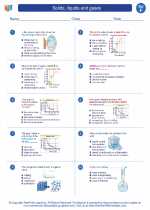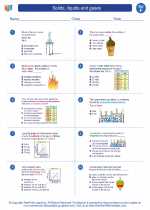Solids, liquids and gases -> gay-lussac's law
Gay-Lussac's Law
Gay-Lussac's Law describes the relationship between the pressure and temperature of a gas at constant volume. It can be expressed mathematically as:
center;">P1/T1 = P2/T2
- P1 = initial pressure
- T1 = initial temperature (in Kelvin)
- P2 = final pressure
- T2 = final temperature (in Kelvin)
Key Concepts:
- Gay-Lussac's Law applies to a gas at constant volume.
- As the temperature of a gas increases, its pressure also increases proportionally, and vice versa.
- The temperature must be in Kelvin for the law to hold true. To convert from Celsius to Kelvin, add 273.15 to the Celsius temperature.
- Gases behave more ideally at higher temperatures and lower pressures.
Example:
If a gas has an initial pressure of 2 atm at a temperature of 300 K, what will be its pressure if the temperature is increased to 400 K?
Using the formula P1/T1 = P2/T2, we can solve for P2:
center;">2 atm / 300 K = P2 / 400 K
center;">P2 = (2 atm * 400 K) / 300 K
center;">P2 = 2.67 atm
So, the pressure of the gas at 400 K will be 2.67 atm.
Applications:
- Gay-Lussac's Law is used in various industrial and scientific applications, such as in the design and operation of pressurized containers, air conditioning systems, and chemical reactions involving gases.
- Understanding the behavior of gases under changing temperature and pressure conditions is crucial for safety and efficiency in many engineering processes.
[Gay-lussac's Law] Related Worksheets and Study Guides:
.◂Science Worksheets and Study Guides Sixth Grade. Solids, liquids and gases
Study Guide Solids, liquids and gases
Solids, liquids and gases  Activity Lesson
Activity Lesson Solids, Liquids & Gases
Solids, Liquids & Gases  Worksheet/Answer key
Worksheet/Answer key Solids, liquids and gases
Solids, liquids and gases  Worksheet/Answer key
Worksheet/Answer key Solids, liquids and gases
Solids, liquids and gases  Worksheet/Answer key
Worksheet/Answer key Solids, liquids and gases
Solids, liquids and gases  Vocabulary/Answer key
Vocabulary/Answer key Solids, liquids and gases
Solids, liquids and gases  Vocabulary/Answer key
Vocabulary/Answer key Solids, liquids and gases
Solids, liquids and gases 

 Activity Lesson
Activity Lesson
 Worksheet/Answer key
Worksheet/Answer key
 Worksheet/Answer key
Worksheet/Answer key
 Worksheet/Answer key
Worksheet/Answer key
 Vocabulary/Answer key
Vocabulary/Answer key
 Vocabulary/Answer key
Vocabulary/Answer key

The resources above cover the following skills:
PHYSICAL SCIENCE
Energy
Students who demonstrate understanding can:
Plan an investigation to determine the relationships among the energy transferred, the type of matter, the mass, and the change in the average kinetic energy of the particles as measured by the temperature of the sample.